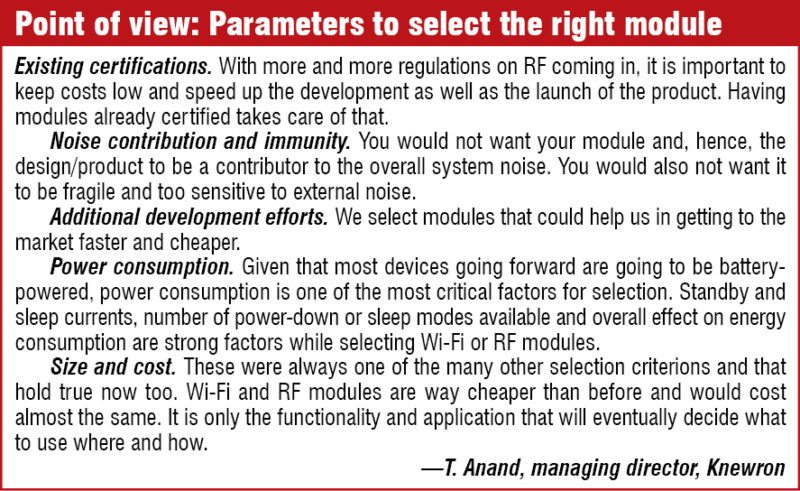Shawn Hymel, creative engineer, SparkFun Electronics, informs that companies such as TI and Atmel are creating smaller, more integrated and lower-power Wi-Fi solutions. He says, “Atmel ATSAMW25, for example, contains an integrated ARM Cortex-M0+ processor along with a full 802.11 b/g/n stack. Other chips offer both Bluetooth and Wi-Fi on a single chip.”
He adds, “These modules are being used to create remote sensors the size of a fingernail that can post data to Web services like Xively, AT&T’s M2X, IBM’s Bluemix, data.sparkfun and so on.”
ESP8266 based modules are mainly universal asynchronous receiver/transmitter (UART) based modules and can act as access points by themselves, along with a standard Wi-Fi mode, informs Anand. He says, “Espressif has also released a software development kit (SDK) for the chip, so that one can actually fully unleash the potential of the chip and use all other general-purpose inputs/outputs (GPIOs) of the chip/module.”
He adds, “You probably would not need another microcontroller for your small IoT applications as the SoC would give you one analogue-to-digital converter (ADC) and eight to ten GPIOs—all being pulse-width modulation (PWM) and interrupt capable.”
Being in the market for over seven years, there have been significant advancements in Microchip’s module offerings too. Abhinay Venuturumilli, Wi-Fi product line manager, WPD Marketing, Microchip Technology Inc., says, “The new additions to our portfolio in the past year include BLE module RN4020 and Bluetooth dual-mode module BM77 that has very small footprint and supports Bluetooth 4.0.”
He adds, “Microchip has also released a sub-GHz module based on the new LoRaTM technology, enabling long-range coverage for low-power embedded applications.” This RN2483 433MHz/868MHz module is ideal for battery-operated sensors and low-power applications such as the IoT, machine-to-machine (M2M), smartcity, sensor networks and industrial automation.
CC3200, a Wi-Fi SoC with an integrated controller with video and audio interface, is a competitive solution from TI, and is apt for applications like home security. Ganapathy says, “We have launched C3200 as a module and chipset. It consumes very low power and can operate on batteries. There are very few modules in the market that can operate on batteries.”
Talking about a feature trend on the software side, Dhananjay Kulkarni, COO, Maven Systems Pvt Ltd, informs, “We now see mesh platforms being made available on more and more RF and Wi-Fi modules. Mesh algorithms allow a reach of several kilometres even if point-to-point range is only few tens or hundreds of metres.”
He adds, “This is especially useful in case of applications such as street lighting, smartmeters, solar panels and windmill farms. The mesh-enabled RF and Wi-Fi modules convert many applications from wired to wireless and provide redundancy/high availability in the process.”
General selection criteria
Listed below are parameters that you could consider before locking down on a particular module for your next design.
Select the right wireless technology. It is important to choose the right kind of wireless standards that the end application would support. Ganapathy feels, the designer needs to figure out the right technology such as NFC, Bluetooth, BLE, ZigBee, 6LoWPAN, Wi-Fi or even proprietary RF for the end application. Each of these come with their own share of advantages.
He says, “NFC uses very low power, whereas BLE requires more power. ZigBee or 6LoWPAN provide designers with an option of meshing, which is not available with other technologies. With meshing, even if one node fails on the network, it is possible to get data via other active nodes.” He adds, “6LoWPAN and Internet protocol (IP) can help in easy connectivity to IP based networks, making connecting to the cloud or the Internet easy.”
“Bluetooth has been at the forefront of connecting sensors, boards, devices, accessories and peripherals to the Internet via various control devices like modems, mobile phones, dongles and PCs,” says Niraj Jha, CEO and MD, Fab.to.Lab.


He adds, “In its latest avatar, the research on Smart Bluetooth (previously BLE/BT 4.0), as named by the pioneers in the industry in this field, is primarily focused on improving power consumption without significant compromises in range.” There are various other protocols like Zigbee, Z-wave and EnOcean, which are available readily in modules for prototyping and experimenting with wireless.
Highlighting a problem of choosing Wi-Fi for an IoT application, Hymel shares, “Unlike Bluetooth, which allows devices to discover each other, Wi-Fi requires the client device to make a connection with Wi-Fi access points (AP) first. This works well from a computer or smartphone where you can enter Wi-Fi credentials, but most IoT devices do not contain an easy-to-use interface, such as a keyboard or touchscreen.”






